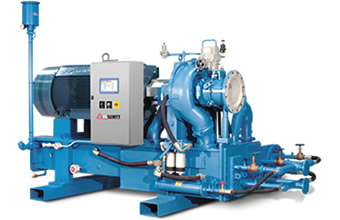| 選擇適當的空壓機需考慮的因素大致分為九要點, 壓力、 排氣量、 電源、環保要求、安裝方式、冷卻方式、噪音值要求、控制方式、效率要求,空壓運用達人將會一一為您說明。 | |
| 1. | 壓力 |
| 空氣壓縮機的排氣壓力(kg/cm²),除了以實際使用 的壓力為基準外, 還必須加上空氣在輸送管路及清淨化系統中的壓力損失。 管路壓力降:壓縮空氣在管路中的損失,就如同交通工具在道路上行駛,當路寬、筆直且距離短、少彎路,便能減少在交通時間上的消耗。一般管路的損失約為0.5 kg/cm²,壓縮空氣通常須經清淨化系統處理,透過管路進行熱交換的乾燥,或透過過濾器,進行清淨的程序,都會產生壓力降,大概是 0.3~0.5 kg/cm²(過濾器 + 乾燥機)。 |
|
| 2. | 排氣量 |
| 實際排氣量:利用儀器以標準測試法,測得空氣壓縮機經過壓縮程序後,所輸出的空氣量。 活塞變位量:即理論排氣量,亦即為不計任何機械能的損失和效率因素,依學理上的推論,經過公式的計算而導出來的結果。一般而言,單段壓縮乘以0.65、雙段壓縮乘以 0.8則似於實際排氣量。因此,排氣量的選擇,應該考慮到以下幾點: (A) 目前的需求量(100%) (B) 可能的管路洩漏量(10%) (C) 將來的擴充計畫(20%~50%) (D) 使用的裕度(10%~30%) 也就是,排氣量的選擇=(A+B+C)x(1+D),當C值愈大的時候,D值可以適當的降低。要特別注意,衡量的標準是按照「實際排氣量」。 |
|
| 其他考慮因素: | |
| 1. | 電源 |
| 空壓機所使用的馬達依照電源的不同,可分為單相或三相: 單相:通常的電壓為110V、220V,為方便及安全性而言,1hp以下可使用110V,1hp以上可使用220V,5hp或以上馬力不適用單相電源。 三相:常見的電壓數為220V、380V、440V,三相馬達通常使用在較大馬力的機種上。 世界各國及各地區有不同的供應電源,不同的電壓,不同的頻率,不同的電氣法規,在選購空壓機時,必須說明使用的電壓,頻率及相數,以便使廠商正確裝配空壓機的電氣控制配備。在使用空壓機前,需先確認電壓與空壓機馬達的名牌相符。 |
|
| 2. | 環保要求 |
| 空壓機依照其結構的不同,可區分為有油式空壓機及無油式空壓機兩種,使用者可依照工作上的實際需求來做選擇。 有油式:凡必須以潤滑油潤滑機體內部及壓縮部者稱為有油式,其產生的壓力空氣含有微量的油氣,雖含有微量的油份但仍適合一般工業使用,對某些工業使用而言,則可裝置過濾器以除去過多的含油量,通常新機在運轉若干小時後,就須更換一次潤滑油,之後須定期更換,若不定期更換或者是選用了不當的潤滑油,則會對空壓機內部零件造成損害,正確的潤滑油選擇和定期更換的間隔,請參考使用說書。適用對象:鋼鐵、塑膠、模具、加工業…及一般製造業使用。 無油式:無油式的零件採用特殊自潤性材質製作,不須藉由潤滑油,即可達到壓縮部的潤滑效果。所以產生的使用空氣中不帶油份,可滿足某些行業需要無油空氣的要求。適用對象:精密工業、醫療、食品、半導體、塗裝等產業。基本上有油式空壓機有廢油的問題,油污的問題,以及洩放水中含有油份這些都必須依照環保法規的要求妥善處理。 |
|
| 3. | 安裝方式 |
| 依照使用情況可選擇: 移動式:小型的空壓機皆採用移動式,採用二輪或四輪以方便使用者的機動性要求。 固定式:較大型的空壓機,因其體積重量已不適合移動,及其配管固定的需求,再加上為減少震動,降低噪音,大部份皆採用固定方式安裝,安裝時需注意固定強度及水平問題。 |
|
| 4. | 冷卻方式 |
| 冷卻的功能有下列幾種: 降低機體溫度,延長機械壽命及減低揚油。 降低排氣溫度,提升乾燥效能。 提供安全保障,防止機件過熱發生意外。 水冷式:須加裝冷卻循環水塔。利用水的流動來達成氣缸和排氣管路的熱交換,是種極具效率的散熱方式,適用於較大馬力機型。 氣冷式:利用風扇產生之冷卻氣流來達到氣缸與排氣管路的熱交換,是種設計簡單、裝配方便的散熱方式。近來漸以具效率的氣流設計,成為大小馬力機型通用的冷卻系統。 空壓機安裝空間之注意: 良好的通風和足夠的空間應為首要原則。在配置位置上,往復式冷卻扇面和牆壁間距離至少應30cm以上,螺旋式排氣面和牆壁間距離至少應1m,距屋頂至少應1.5m。 |
|
| 5. | 噪音值要求 |
| 空壓機的噪音通常來自下列各處: 機體的運轉:壓縮過程中,快速的運轉作動產生機械的聲音,空氣吸進、排出的聲音,氣流的聲音,摩擦的聲音,及散熱風扇運轉的噪音。 動力源產生:電動機〈馬達〉或引擎帶動空壓機運轉,本身產生的運轉噪音。 機體不平衡:平衡校正不佳或安裝未重視水平皆會使機體及鈑金產生震動而發出噪音。 排氣的洩露:排氣管路的洩漏及高壓氣體的流動皆會產生噪音。 各機種由於其作動方式及結構不同,所產生的噪音程度也有差異: 開放型往復式:來自活塞往復式運動產生的噪音未做任何阻隔,隨聲波向環境散播。小馬力噪音小,不影響環境,大馬力噪音大,必須做適當處理。 箱型往復式:雖箱型內部機體與開放式機種相同,但因箱型鈑金經特殊設計,採用高級吸音材料,防震材料及阻隔音源的設計,降低了相當的震動及噪音。 螺旋式:由於螺旋式的作動方式不同,所產生的音頻與往復式不同。螺旋式通常為箱型設計且其鈑金使用高級吸音材料,防震材料及阻隔音源的設計,因此噪音值通常較往復式低。 噪音的防止並非達到絕對無音的狀態,而是希望將過高的音量降至工作環境可接受、或與環境相對,一般皆要求在75分貝以下。由於使用以及經濟性的考量下,當環境上並無太大限制及需求下,開放式機型即是通常的選擇,在要求生活品質及工作品質環境又受限的情況下,箱型是適當的選擇。 |
|
| 6. | 控制方式 |
| 空氣壓縮機的控制方法應依不同的使用狀況及使用量作適當的安排,方能使壓縮效能及機械壽命達到最高。以氣冷式小型機為例,目前所使用的操作方式分為半自動操作與全自動操作二種。 半自動式:利用自動釋荷閥(Automatic Unloading System)來控制空壓機的空車、重車。其作動原理為當系統氣壓力超過設定上限時,自動釋荷閥驅動溢氣活塞使進氣閥保持開啟而呈現空車狀態。 全自動式:利用壓力開關(Pressure Switch System)來控制馬達的運轉。當系統氣壓超過壓力開關設定壓力上限時,繼電開關離開,中斷馬達電源,空壓機停止運轉;當系統壓力降至設定下限,繼電開關接通馬達,空壓機繼續運轉恢復壓縮空氣。此方式適用供氣不頻繁之間續使用及較小馬力。 在實際運轉的控制應用上,下列選擇方式可提供更彈性的運用。建議: ◆ 全/半自動選擇控制 - 建立控制系統視實際狀況來選擇控制方式。 ◆ 全/半自動自動轉換控制 - 由微電腦控制系統視操作狀況機動選擇控制方式。 |
|
| 7. | 效率要求 |
| 不同型式的空氣壓縮機因其結構設計,使用壓力,排氣量,壓縮段數的不同,各有其較有利的效率區段,基本上: 較低壓力,較小馬力;以選用往復式為主。 10hp以下機種,而又需兼顧靜音時,可選擇渦捲式或箱式靜音型。 20hp(馬力)以上:以選用螺旋式或水冷式為主。 12kg以上的較高壓力:以選用兩段式高壓往復式為主。 |
|
| Choosing the most suitable air compressor according to the following nine factors: Pressure, air discharge amount, electric power, environment protection requirement, installation method, cooling method, noise restrictions, operating method, and efficiency requirement. Below are the details of the nine factors. | |
| 1. | Pressure |
|
Air compressor’s pressure for air discharge (kg/cm²) uses the actual pressure using as the benchmark. In addition, the pressure loss during the air flows through the cleaning system is also needed. Pipe pressure decrease: The compressed air that was lost in the pipe, is similar to the traffic situation, when driving on a wide, straight road the time in driving will be lesser. General pipe’s loss is approximately 0.5 kg/cm². Compressed air is usually required to flow through cleaning system or filter elements, which would become dry and leads to decreasing the pressure, at the approximate amount of 0.3~0.5 kg/cm² (filter element & dryer) |
|
| 2. | Amount of Air Discharge |
|
Actual amount of air discharge: It can be measured by using measuring instruments according to the amount of air output after the air compressing process. Piston displacement amount: It is calculated according to theory calculations, without any data from the loss and efficiency measurements. Generally, a phase compressor is multiplied by 0.65, while double phase compressor is multiplied by 0.8 in order to have the closest actual amount of air discharge. Therefore, there are 4 considerable factors for the theory calculation to be possible: |
|
| Other considerations: | |
| 1. | Electric Power |
|
Different models of motor required different electric power, usually it can be separate in two types: |
|
| 2. | Environment Protection Requirement |
|
With the different design of air compressors, it can be separate as with and without oil. With oil: Oil is used to lubricate inner part of air compressor. Although it has a rarely little oil, but it is still perfectly fine for general industry users. For some industries, it is recommended to install filter for removing large amount of oil. It is required to change the lubrication oil for the first startup after few hours. Later on, the lubrication oil should be change constantly, and not to use bad quality lubrication oil for not damaging the parts. Please refer to the “Technical Manual” for the correct use of lubrication oil and changing routine time. It is suitable for: Iron, module, and general manufacturing industries. Without oil: Parts for without oil models will lubricate itself by its own part design. Therefore, it will be 0% oil contain. It is suitable for: high precision industry, medical industry, food industry, semi-conductor industry, painting and coating industry. Models of air compressor that has oil with it, will contain problems such as slop oil, oil stain, and water with oil leaking. It is important to strictly follow the instructions and policies of environmental protection. |
|
| 3. | Installation |
|
According to the situation, there are two options: Portable: small air compressors are all portable with two or four wheels beneath for convenient in moving. Fixed: big size air compressors are not able to move around due it its size, pipes organizing, noise and vibrations that it might cause. It is important to be aware of the fixed power and its horizontal surface. |
|
| 4. | Cooling Method |
|
The following are the main purpose for cooling: Decrease main part’s temperature for longer life span. Decrease air discharge’s temperature for increasing performance of dryer. Provide safe working environment, prevent from the machine overheat which may cause accidents. Water Cooling: cooling cycle tank is required. By using water’s flow to let cylinder and air discharge’s pipe having chemical reactions, which is high efficiency in cooldown that suits for large hp models. Air Cooling: air that cool by fan flows to cause chemical reactions with cylinder and air discharge’s pipe is a simple design in cooldown. With its improving and better developing, both big and small hp models of cooling system is suitable. Remark: Enough space and ventilation are the priority when installing. For the positioning, reciprocating type cooling fan and the wall should have a distance at least 30cm; screw type at least 1m, while at least 1.5m gap from the roof. |
|
| 5. | Noise |
|
Several noise of air compressor cause from the following reasons: Performance of Air Frame: during the process of compressing, high speed rotating, air inlet, air discharge, air flow, and cooling by the fan. Motor: motor or engine. Air Frame Unbalanced: Calibration incorrect or the horizontal surface wasn’t concerned while installing. Leakage of Air Discharge: leakage from pipe or high air pressure’s flowing could also cause noise.
Freely open reciprocating type: the noise generated by the reciprocating movement of the piston is not blocked, and is spread to the environment with sound waves. Low hp’s noise won’t affect the environment, but big hp’s noise must be treated immediately. Tank reciprocating type: although its inner part air frame is the same as the freely open kind, but its sheet metal was customized by using high quality materials to absorb noise, prevent vibrates, and ignores sound source. Screw type: its performing method is different comparing to reciprocating type, so the audio frequency is different. Screw type is also design like tank kind, its sheet metal was customized by using high quality materials to absorb noise, prevent vibrates, and ignores sound source. |
|
| 6. | Operating Method |
|
Different models and different usage operate differently, so that the performance and its life span can be maximize. Using small size with air cooling as an example, there are two types of operating method: Semi-auto: by using the automatic unloading system to operates air compressor’s light load and fully load. It is when system’s air pressure is greater than the set maximum amount, automatic unloading system drives bleed piston makes the inlet valve open mode to make it as the light load. Fully-auto: by using pressure switch system to operates motor’s performance. When system’s air pressure exceeds the set maximum amount, relay switch is no longer available, the motor’s electric power is stopped, and the air compressor stops performing; when the system’s pressure decrease to set minimum amount, relay switch will connect to the motor, and the air compressor will continue to perform. This method is suitable for less hp.The following methods are somehow flexible in applying: ◆ Fully/Semi-auto choosing operation: create operating system depending on actual situation to choose operate method. ◆ Fully/Semi-auto automatic switch operation: Computer program will choose operation method according to actual situation. |
|
| 7. | Efficiency Requirement |
|
Different models of air compressor have different designs and structures; Therefore, the pressure usage, amount of air discharge, and phase of compressing is different. To make it simple, we categorize into four categories: Low pressure with low hp, use reciprocating kind. Models below 10hp also with no noise, turbine or tank kind mute type would suits more. 20hp and above, please use screw type or water-cooling type. For pressure with 12kg or above, please use 2 phase high pressure reciprocating type. |
|
TECHNICAL
技術資料
如何選購空壓機 How to choose the air compressor


